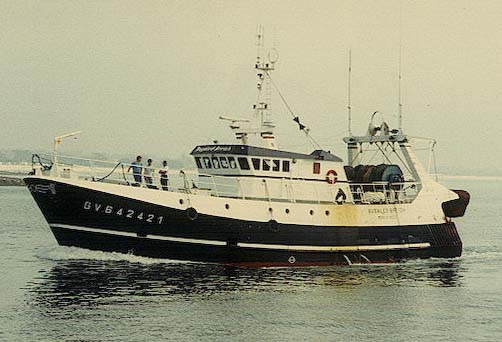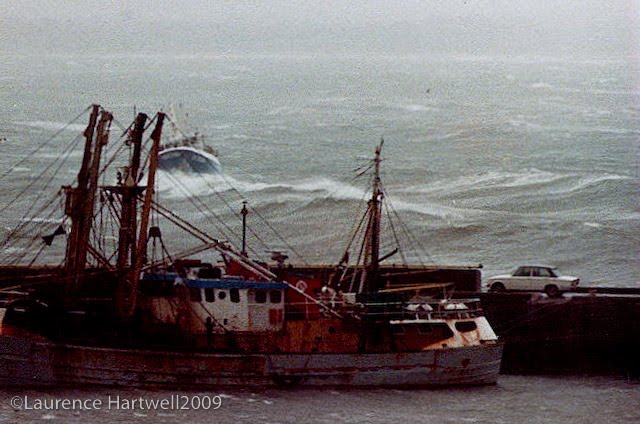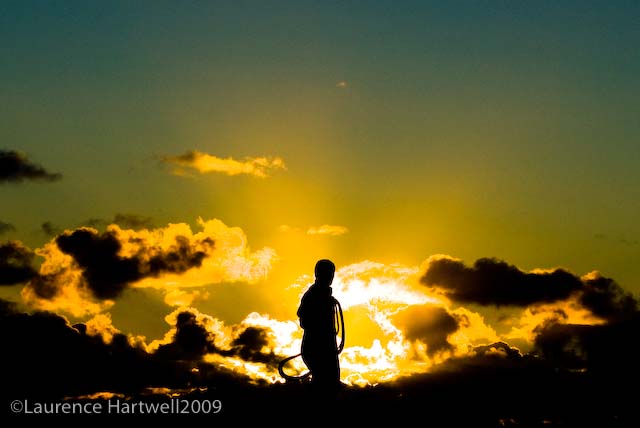 |
| Bugaled Breizh on her way in to Loctudy, her home port in Brittany. |
Three reports from the media in France covering the news today exonerating involvement of the British submarine Turbulence in the sinking of the trawler Bugaeld Breizh, january 15th 2004. The Bugaled Breizh, the second of trawler of that name owned and skippered by Michelle Douce was a regular visitor to Newlyn in times of bad weather. She sheltered in the port only a few days before accident which saw the loss of five lives. Skipper, Michelle Douce was ashore at the time of the loss owing to an injury which had kept him from going to see for nearly a year. He was due to return to sea the next voyage.
 |
| The Bugaled Breizh entering Newlyn harbour sheltering from bad weather around 1995 |
 |
| Watched by Billy Stevenson from the comfort of his car, another Loctudy trawler, Kristel Vihan enters Newlyn 24 hours after the local fleet had tied up for weather. |
A new expert report submitted to the judge questions the origin of traces of titanium hull trawler, which was attributed to a far underwater. The plaintiffs react.
By Stéphane GrammontPosted on 25/01/2013 | 11:10
The mystery remains about the causes of the sinking of Bugaled Breizh off Britain in 2004. Two experts, whose results were released Friday by the prosecutor of Nantes, away from the idea of the involvement of a submarine in the accident, which left five missing.
The first expert examined the presence of titanium on the warps (cables) Breton trawler. According to Brigitte Lamy, the prosecutor, this data is "not significant involvement of a submarine." The second expertise, the British submarine Turbulent, involved a time in the accident, was "well dock" the day of the sinking, said Brigitte Lamy, in a comminiqué.
The victims' families have been waiting several months these two appraisals. They are convinced of the involvement of a submarine sinking brutal, remained unexplained, the trawler. January 15, 2004, during the accident, NATO and the British Navy conducting military exercises in the area.
The two judges of Nantes in charge of the case had appointed three experts to check whether the traces of titanium found on the trawler could have come from contact with a submarine. "At the end of this report, which has been filed, the experts have to say that the element 'titanium' found in tiny amounts on the warps Bugaled Breizh were not significant involvement in a submarine, "wrote the attorney Nantes.
On the other hand, a separate report, told a French specialist submarine forces, was to examine the possible involvement in the sinking of the British submarine Turbulent. "According to the conclusions of the report and on the basis of technical information relating to the position of military buildings at the time of the sinking, the expert considers that the British submarine in question was well Shore January 15, 2004 and that sea rescue dispatched to the area by the British authorities have been under normal conditions, "the statement said Brigitte Lamy.
The wreck of Bugaled Breizh is bailed small
Traces of titanium found on the warps Bugaled Breizh led the judges of Nantes, in charge of the case since July 2012, to nominate three experts. They should check whether these traces could be from a collision with a submarine.
Counsel for the Republic of Nantes Brigitte Lamy said in a press release that " the element "titanium" found in tiny amounts on the warps Bugaled BREIZH was not significant involvement of a submarine. " Indeed, apart from two Russian submarines designed in the 60s, the exterior of submarines, whether conventional or nuclear attack is free from any form of titanium, which does, in very low levels in the sub-layers of paint.
Experts could not say, for against that titanium could come from the original painting of Bugaled Breizh. It is not only present in the form of dioxide in painting trawler, but also in other ports. Traces on the warps can been made by friction on the hull or on the docks. reaction of Me Kermarrec, counsel for the plaintiffs
Moreover, the statement continued, "a separate report was presented during the fall, a French specialist submarine forces, charged by the judges to give its opinion on the possible involvement of a submarine of the Royal Navy."
According to the conclusions of the report and on the basis of technical information relating to the position of military buildings at the time of the sinking, the expert considers that the British submarine in question was well Shore January 15, 2004, as did know his commander, and the sea rescue dispatched to the area by the British authorities were in normal conditions. Bugaled Breizh The case of a timeline
Story courtesy of Bretagne newspaper.
The trawler sank Bugaled Breizh January 15, 2004, in international waters of the English Channel, off the Lizard. Five sailors died in the sinking.
----- 2004 -----
- 15 January: Bugaled Breizh sank off the Lizard (south-west England), killing five crew members. The next day, the maritime prefecture of Brest reveals that international military exercise took place in the area.
- January 19: Attorney Quimper excludes a collision with a submarine and evokes a collision with a container Philippine, Seattle Trader.
- June 7: analyzes paint exonerate the Seattle Trader.
- July 10: The wreck is raised.
----- 2005 -----
- March 24: private expertise advance the "most likely hypothesis" a"note" with a submarine thesis rejected by the Ministry of Defence.
- April 14: Journalists refer to the British submarine Turbulent, denies that the British Ministry of Defence.
- October 13: The Bureau of Investigation and Analysis (BEA Wed) does not track the submarine.
- December 9: lifting of military secrecy on military exercise Jan. 15.
----- 2006 -----
- July 20: Defence said he sent to Justice "all documents declassified NATO" .
- 1st September: after new expertise, the judge mentions "the hypothesis of a building submarine" .
- September 21: National Laboratory tests revealed traces "unexplained"titanium on the trawl cable port, reinforcing this view.
- 27 November: BEA Wed concludes hooking a sandbank by the fishing gear and not a submarine.
----- 2007 -----
- February 28: Attorney says no submarine was British or Dutch in the area.
----- 2008 -----
- March 5: Families complain of poor international cooperation and require the intervention of President Nicolas Sarkozy.
- April 12: The judges reaffirm that submarine hypothesis is "the most serious in the state of the record" , that denies the floor.
----- 2009 -----
- January 13: The judge rejected the family's request to investigate the position of the submarine. They call.
- November 11: Minister of Defense Herve Morin promises to "put everything on the table" and provides that "no French submarine" is involved.
- November 27: The Court of Appeal of Rennes ordered a further investigation and entrust this task to the expert Dominique Salles, a former submariner.
----- 2010 -----
- April 30: report mentions the alleged liability of a U.S. submarine.
- July 2: Court of Appeal of Rennes decided "further judicial information in order to identify the submarine in question" and appointed two new judges to Nantes.
----- 2011 -----
- June 17: A new report concluded that the titanium one of the cables of the trawler "can not be considered as an indication of the presence of a submarine" . This report from Mr. Salles, a former submarine officer, is described as "dirty trick" by a lawyer of the victims.
----- 2013 -----
- January 25: expertise, at the request of judges assigned to the case Nantes, considers the presence of titanium cables trawler as
"no significant involvement of a submarine" , and a second concludes that the British submarine Turbulent was "
well dock " that day
NB: These stories have been mechanically translated by Google.




















